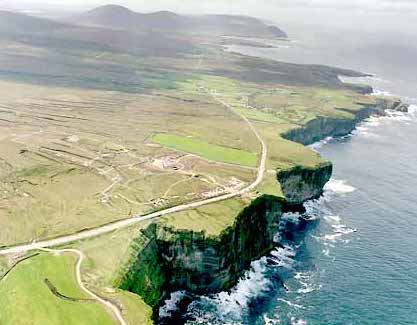History of Céide Fields
Discovery
The discovery of what is now known as Céide Fields really began back in the 1930s when a local schoolteacher, Patrick Caulfield from Belderrig, often noticed piles of stones in the bottom of the bog when cutting his turf.
To everybody else these were meaningless but he realised two very important points - firstly, the way the stones were piled up couldn't be natural so somebody had to put them there, and secondly, because they were down underneath the peat they had to be put there prior to the growth of the bog and so must be very ancient.
It was however to be another 40 years and only when this man's son, Seamus, became an archaeologist and began studying these stones in the bogs that it was realised what they were all about.
It is now known that these are the remains of a Stone Age landscape of stone walled fields, houses and megalithic tombs over 5,000 years old, preserved beneath the growing blanket bog over thousands of acres in North Mayo.
The continuing research, involving the location and mapping of these hidden walls by a specially developed simple and completely non-destructive method of probing with iron rods, and excavation of habitation sites and tombs is yielding a unique picture of the way of life of our ancestors 200 generations ago.
We now know that they were a highly organised large peaceful community of farmers who worked together on clearing hundreds of acres of forestry and dividing the land into regular field systems.
Their main economy was cattle rearing but they were skilled craftspeople and builders in both wood and stone and also had strong spiritual beliefs.
The Visitor Centre
In 1989 a project was launched by Dr. Seamus Caulfield and Prof. Martin Downes along with a local committee to build a Centre at Céide which would use the results of the research as an economic resource by attracting tourists to the area.
The following year the OPW became involved and designed the award-winning Centre which was opened to the public in May 1993.
The Centre not only presents the archaeology of the site but also the botany, bogs and geology of the area. It is located beside spectacular 370ft high cliffs, five miles west of Ballycastle.
Visitors to the Centre can enjoy an audio-visual show as well as the exhibitions inside, including a magnificent 4,300 year old Scots Pine tree which dominates the centre of the building.
A panoramic viewing platform both inside and outside on the roof of the glass topped pyramid shaped building affords dramatic views of sea and land.
Guided tours along pathways on the bog bring visitors around one of the stone walled fields, a domestic enclosure and an animal pen.
The technique of probing for the hidden walls is demonstrated and people are welcome to try it for themselves and experience the thrill of finding and feeling a stone wall which has been hidden underneath the peat for over 5,000 years.
The diverse flora of the bog can be seen including mosses, lichens, heathers, sedges and insect-eating sundews, and in early summer the bog is a carpet of colour from flowering milkworts, tormentils, orchids, bog cotton and other plants.


Ceide Fields
Ballycastle
County Mayo
+353 (0) 96 43325
ceidefields@opw.ie
www.ceidefields.com
Sneak Peek
Some interesting items can be viewed here
- Granny in Bed
- Ancient Pine Tree
- Ballyglass House
- Belmullet Gneiss Rock
- Beard Lichen
- Bog Cotton
- Common Butterwort
- Ceide Cliffs
- Ceide Midge
- Dún Briste
- Eagle's Eye View
- Giant Irish Elk
- Heath Spotted-Orchid
- Ling Heather
- Matchstick Lichen
- Milkwort
- Neolithic Field Wall
- Plough and ploughmarks
- Pottery
- Probing
- Saddle Quern
- Sundew
- Tapestries
- The Enclosure
- The Ice Age
- The Quarry
- Turf Bank